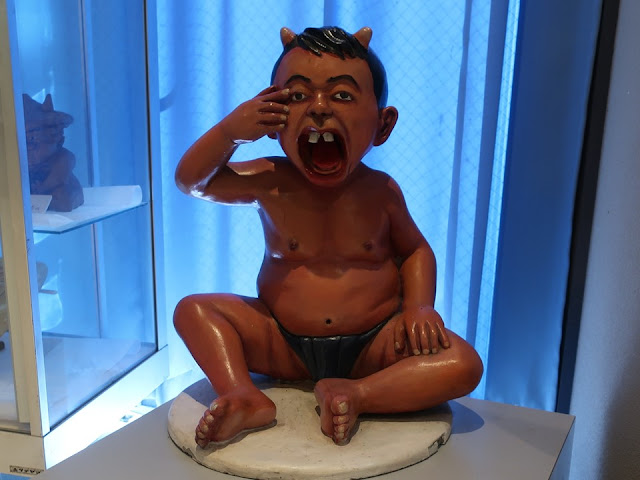What is “Oni” ?
If you look up “Oni” in a Japanese-English dictionary, it is translated as “demon” or “ogre”. However, it is not correct.
Some are bad (demons/ogres) like Oni in “Demon Slayer” (Kimetsu-no-Yaiba, Movie). However, others help people and they are enshrined.
This museum is at the foot of Mt.Ohe
which has a legend that bad Oni lived and samurai warriors killed them. It
is located in the northern part of Kyoto prefecture.
It exhibits Oni masks, Oni roof tiles etc. and it introduces events and legends in which Oni appeared. Actually, Oni have various aspects.
鬼退治伝説がある京都府北部の大江山の麓にある博物館です。鬼瓦や鬼の面が展示され、鬼がでてくる行事や伝説が紹介されています。
「国内外の鬼文化に関する資料を展示し『鬼とはいったい何者か』に迫ります」、とリーフレットに書かれていますが、展示室にパネルには「その答えを出すのはあなた自身である」と書いてました。
その通りです。人間社会において、鬼はいろいろな役割を持っていますが、多分、人間の味方と捉えている人達が多いと思います。「鬼滅の刃」とはちょっと違う見方ですね。
Museum on the right. On the left is the face of a large Oni made from pottery, made of materials from all over the country.
右側が博物館です。左側は焼き物で作った大鬼の顔、全国各地で作った素材でできています。
Genealogy of Oni、鬼の系譜(痛恨のピンボケ)
Japanese Oni originated from demons of India, China, Korea and other Asian countries around a thousand years ago.
Some changed to be weird, strong and scared Oni which were described in folklores, local performances, religions and so on. Others changed to be vengeful and bad demons (onryo) described in historical documents and so on.
Oni tile、鬼瓦
Oni tile is large and decorative one at the edges of the Japanese tiled roof; it drives disasters away. Oni tiles across Japan are exhibited. The Oni protect us.
まず、全国の鬼瓦の展示。魔除けの役割を果たしています。この鬼は味方。
Scary~、迫力があります。
Enshrined Oni、祀られる鬼
Until bad Oni appeared, all Oni were deities and they are enshrined at many places even now. Those Oni guard offspring. Some of them appear in the local events such as Namahage in Akita. Oni protect us.
悪鬼が現れるまでは、鬼は神でした。各地の鬼神社に鬼が祀られています。
子孫を見守る先祖神・来訪神的な性格を持ち、ナマハゲなどの民俗行事に残っています。九州では、門松を鬼木(おにぎ)といったり、ドントの火を鬼火と呼んでいるそうです。ここでも鬼は味方です。
Straw Oni dolls (Iwate pref.): people expect those strong Oni to protect a village. This practice started after the famine in the 18th century.
鬼の藁人形(岩手県安代町):天明の大飢饉の後、強い鬼に村を守ってもらおうと思って作った男女の鬼です。鬼は味方です。
Oni in local festivals、民俗芸能の鬼(まつりと鬼)
People welcome Oni and enjoy with them. They are friends.
民衆は、鬼を丁寧に迎え、共に遊びます。ここでも鬼は味方です。
Oni of the flower festival in Oku-Mikawa (Aichi pref.): he stamps his foot to suppress devils under the ground.
花まつりの鬼(奥三河):四股を踏むような所作をして、地中に潜む悪霊を鎮めます。
Yagorou-don in Oosumi (Kagoshima pref.): it has a height of 6m. People touch his hands on the festival day to be in sound health.
弥五郎どん(鹿児島県大隅町):六メートルの大男です。祭礼の日に弥五郎どんの手に触れて、無病息災を祈ります。
Masks of Gojinjo Taiko (drum performance) in Wajima (Ishikawa pref.):
The army of the strong general Kenshin Uesugi surged the area in 1576. Villagers wore Oni masks and seaweeds for hair, then they hit drums and attacked the position in the night. The troop retreated and never invaded afterward.
The villagers were grateful to their village god and have continued offering Gojinjo Taiko performance to the shrine.
Reference (movie): https://www2.nhk.or.jp/archives/michi/cgi/detail.cgi?dasID=D0004990265_00000
輪島の御陣乗太鼓の鬼の面です。1576年、押しよせた上杉謙信軍に、名舟の村人はこの面を被り、海藻で作った長髪を振り乱して、陣太鼓を打ち鳴らしながら、夜陰に乗じて攻め寄せました。上杉軍は後退し、二度と攻めることはありませんでした。村人たちは氏神に感謝し、御陣乗太鼓の奉納を続けています。
Female Oni、女の鬼
Most of them are enemy of ordinary people. Some attack children, others eat people in a mountain.
The typical one is “Han-nya” in the photo above which has distinctive eyes and a split mouth. However, it is written that the face still has trace of a beautiful lady. I didn’t know that.
子供を襲ったり、地獄で亡者を痛めつけたり、人を喰う山姥だったり、女の鬼は人間の敵が多いです。女の鬼の典型は般若で、目はつり上がり、口が裂けながらも、美しい女の面影を残す、と書かれていました。そういうことですか。
Oni in Mt.Ohe、大江山の鬼
After samurai warriors emerged, they got rid of Oni; Oni became enemies.
退治される鬼と書かれています。武士が現れて、鬼は武士に退治される敵役になったと書かれていました。
Do you find Oni in the picture? They are the bad creatures here.
鬼を見つけられますか。鬼は敵です。
Killing Shuten Douji (Oni) gangs in 990; they resided at Mt.Ohe. The emperor ordered Raikou Minamoto to subdue them. The exhibit above is a copy of his optative sentence.
大江山の酒呑童子一味の退治(990年):一条天皇が源頼光に鬼賊討伐を命じました。頼光の祈願文(複写)です。大江山の鬼は、鉱毒がつきもののタタラ師であったという説も書かれていました。
Shuten Douji in the puppet show in Tokushima pref.; so big!
徳島・阿波人形の酒呑童子。巨大ですね。
Btw, “Shuten” means drinking sake (alcohol). It is said Oni drink a lot.
The exhibits above are different labels of sake bottles all over Japan. Most of all brands are “Oni Koroshi(killing)” which means that even Oni would get drunk and die if they drink these sake. Good marketing. But there is one label “Oni Konomi (Oni likes this)”.
鬼は大酒飲みだとされています。鬼も酔う「鬼ごろし」が有名ですが、「鬼このみ」というラベルもあります。
Tengu、天狗
Tengu which has a long nose is different from Oni. It is a ruler of a mountain. It says “Tengu is familiar youkai (monster) for Japanese people same as Oni.”
「天狗は、鬼とともに日本人にとって、なじみの深い妖怪である」と書かれています。天狗は山の主で、修験道・山伏と結びついて勢いを増したそうです。確かに、山伏のような服装です。
Oni themed toys、鬼の玩具
Dolls and bells、人形や鈴
Demons in foreign countries、世界の鬼
In Bali Island, "Baji" is enshrined at roadside. It watches children not to be injured or not to get sick, and it calls out when danger looms ahead. It protects children like good Oni.
バリ島の道ばたに祀られているバジ鬼は、子ども達が病気や怪我をしないように見守っています。危険が迫ると声を出して知らせてくれると信じられています。人間の味方ですね。
Many pictures of Oni in Japan are exhibited at the hall; Oni are popular.
ホールにはたくさんの鬼の絵が飾られています。鬼は人気があります。
There is a panel named “Modern Oni”. There are a lot of anxieties in the real world. It’s a time that people expect Oni for giving us some relief.
「現代の鬼」というパネルがあり、妖怪の代表的な存在が鬼であるとした後、岩井宏美氏の「表面的安定、内面的深刻の時代こそ妖怪を求め、また妖怪を共存する時代である」という指摘を引いて、「妖怪願望は人間性回復の願望でもある」と結んでいました。
不安や挫折、理屈で割り切れないことを別の世界に求める、そうかも知れません。
There are statues of Raikou Minamoto and warriors who are going to Mt.Ohe to subdue Shuten Douji (Oni) near the museum.
博物館の近くに、山伏姿で大江山に向かう頼光達のモニュメントがあります。
Reference (the other museum about Oni in northern Japan) :
Visited in October, 2020
Official website: https://www.city.fukuchiyama.lg.jp/onihaku/ (in Japanese), accessed in February, 2021
Previous post (History and folklore museum of this region):
Kyoto
Prefectural Tango Regional Museum (2)、丹後郷土資料館 (2)
Next post (Local
museum in this region):
Maizuru local museum、舞鶴ふるさと発見館

























Comments
Post a Comment